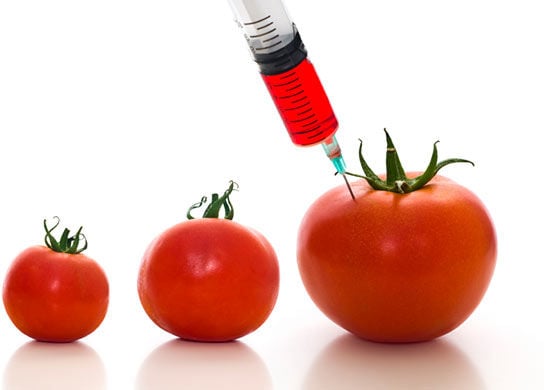Some of our leaders think it is a good idea for Nigeria to start growing GM foods both for human consumption and potentially for exportation. They have reported that GM will increase yield thereby solving hunger problems in the country, will solve malnutrition by introducing bio-fortified foods e.g. Vitamin A Cassava, and will favour our small holder farmers in terms of more cash from sales of crops thereby making our economy better. They have also promised that pests that feed on our crops and cause a loss of produce will be a problem of the past if GM foods are introduced. Also, that GM crops will reduce the use of pesticides thereby ending up being more healthy and nutritious than conventional crops.
The National Biotechnology Development Agency (NABDA) and the likes have been putting pressure on the federal government to pass the biosafety bill, which will allow the operation of biotech giants such as Monsanto to operate in the country thereby putting GM food on your plate for your consumption. Unfortunately, our leaders have once again failed to carry out proper research before trying to pass a policy that will affect the Nigerian population for generations to come. Yet they call people who take their precious time to educate the Nigerian public on the ills of GMO, ‘anti science activists’. I have written extensively on the health hazards associated with GMO and have shown that they aren’t safe to eat. In this article, I will focus on the GMO promises which to a huge extent are myths and give summaries of peer reviewed studies done in many parts of the world.
Myth: GM foods are strictly regulated for safety
Truth: GM food regulation in most countries varies from non-existent to weak
Advertisement
Industry and some government sources claim that GM foods are strictly regulated.
“Monsanto should not have to vouchsafe the safety of biotech food. Our interest is in selling as much of it as possible. Assuring its safety is the FDA’s job.”
– Philip Angell, Monsanto’s director of corporate communications (the FDA is the US government’s Food and Drug Administration, responsible for food safety)
Advertisement
“Ultimately, it is the food producer who is responsible for assuring safety.”
– US Food and Drug Administration (FDA)
“It is not foreseen that EFSA carry out such [safety] studies as the onus is on the [GM industry] applicant to demonstrate the safety of the GM product in question.”
– European Food Safety Authority (EFSA)
Advertisement
GM food regulatory systems worldwide vary from voluntary industry self-regulation (in the US) to weak (in Europe). None are adequate to protect consumers’ health.
The regulatory process in the USA
“One thing that surprised us is that US regulators rely almost exclusively on information provided by the biotech crop developer, and those data are not published in journals or subjected to peer review… The picture that emerges from our study of US regulation of GM foods is a rubber-stamp ‘approval process’ designed to increase public confidence in, but not ensure the safety of, genetically engineered foods.”
– David Schubert, professor and head, Cellular Neurobiology Laboratory, Salk Institute, commenting on a comprehensive peer-reviewed study of US government’s regulation of GMOs.
GM foods were first commercialised in the US in the early 1990s. The Food and Drug Administration (FDA), the US food regulator, allowed the first GM foods onto world markets ignoring reports by its own scientists about how different genetic engineering is to conventional breeding and the risks associated with them including the production of new toxins or allergens. The FDA overruled its scientists in line with a US government decision to “foster” the growth of the GM industry. The FDA formed a policy for GM foods that did not require any safety tests or labelling. The creation of this policy was overseen by Michael Taylor, FDA’s deputy commissioner of policy – a position created especially for Taylor. Taylor was a former attorney for the GM giant Monsanto and later became its vice president for public policy. Many Monsanto top level officials have been given positions at the FDA just as many top level FDA officials have been given position in Monsanto. This is known as ‘the revolving door’ and contributes to weak regulatory policies.
Advertisement
Contrary to popular belief, the FDA does not have a mandatory GM food safety assessment process and has never approved a GM food as safe. It does not carry out or commission safety tests on GM foods. Instead, the FDA operates a voluntary programme for pre-market review of GM foods. All GM food crops commercialised to date have gone through this review process, but there is no legal requirement for them to do so. Companies that develop GM crops are allowed to put any GMO (genetically modified organism) on the market that they wish, though they can be held liable for any harm to consumers that results from it.
The outcome of the FDA’s voluntary assessment is not a conclusion, underwritten by the FDA, that the GMO is safe. Instead, the FDA sends the company a letter to the effect that:
Advertisement
- The FDA acknowledges that the company has provided a summary of research that it has conducted assessing the GM crop’s safety
- The FDA states that, based on the results of the research done by the company, the company has concluded that the GMO is safe
- The FDA states that it has no further questions
- The FDA reminds the company that it is responsible for placing only safe foods in the market
- The FDA reminds the company that, if a product is found to be unsafe, the company may be held liable.
Clearly, this process does not guarantee – or even attempt to investigate – the safety of GM foods. While it does not protect the public, it may protect the FDA from legal liability in the event that harm is caused by a GM food.
GM corporations and the US government have designed the GMO regulatory process around the world
The agricultural biotechnology corporations have lobbied long and hard on every continent to ensure that weak assessment models are the norm. Often working through the US government or non-profit groups, they have provided biosafety workshops and training courses to smaller countries that are attempting to grapple with regulatory issues surrounding GM crops. The result, according to critics, has been models for safety assessment that favour easy approval of GMOs without rigorous assessment of health or environmental risks.
Advertisement
For example, a report by the African Centre for Biosafety (ACB) described how the Syngenta Foundation, a non-profit organization set up by the agricultural biotechnology corporation Syngenta, worked on “a three-year project for capacity building in biosafety in sub-Saharan Africa”. The Syngenta Foundation’s partner in this enterprise was the Forum for Agricultural Research in Africa (FARA), a group headed by people with ties to Monsanto and the US government.
The ACB identified the Syngenta Foundation/FARA project as part of an “Africa-wide harmonisation of biosafety policies and procedures” that will “create an enabling environment for the proliferation of GMOs on the continent, with few biosafety checks and balances”. Having gone through the Nigerian Biosafety bill (which is available for all to see online), it becomes very clear that the bill was written solely for the purpose of enabling big biotech corporation grow GMO with very few biosafety checks and balances.
Advertisement
In India, the US Department of Agriculture led a “capacity building project on biosafety” to train state officials in the “efficient management of field trials of GM crops” – the first step towards full-scale commercialisation. And in 2010, a scandal erupted when a report from India’s national science academies recommending release of GM Bt brinjal (eggplant/aubergine) for cultivation was found to contain 60 lines of text copy-pasted almost word for word from a biotechnology advocacy newsletter – which itself contained lines extracted from a GM industry-supported publication.
Myth: No one has ever been made ill by a GM food
Truth: There is no scientific evidence to support this claim
GM proponents claim that people have been eating GM foods in the United States for 16 years without ill effects. But this is an anecdotal, scientifically untenable assertion, as no epidemiological studies to look at GM food effects on the general population have ever been conducted.
Over the years, there have been signs that the US food supply majorly contributes to the ill health of the population. Reports show that food-related illnesses increased two- to ten-fold in the years between 1994 (just before GM food was commercialized) and 1999. No one knows if these illnesses are linked to GM foods because companies like Monsanto have refused to label their food even though the American public want to know what’s in their food. As a result, US consumers are not monitored for health effects.
In addition, health effects would have to be recorded and reported by a centralized body that the public knew about and that could collate data as it came in and identify correlations. Currently, there is no such monitoring body in place anywhere in the world and with the nonexistent health infrastructure in Nigeria, we certainly cannot boast of one.
Moderate or slow-onset health effects of GM foods could take decades to become apparent through epidemiological studies, just as it took decades for the damaging effects of trans fats (another type of artificial food) or of smoking to be recognised. Slow-poison effects from trans fats have caused millions of premature deaths across the world. To detect important but subtle effects on health, or effects that take time to appear (chronic effects), long-term controlled studies on large populations would be needed. It is worth mentioning that a high-profile case emerged in which a GM food caused illness in people. In 1989 in the US, a food supplement, L-tryptophan, produced using GM bacteria, was found to be toxic, killing 37 people and permanently disabling over 1500 others. The resulting disease was named eosinophilia myalgia syndrome (EMS). Symptoms included an overproduction of white blood cells called eosinophils, severe myalgia (muscle pain), and in some cases, paralysis. Also, in 2011, scientists in Argentina found long term effects of GMO in certain towns where these crops are grown and these include birth defects and a higher incidence of child cancer caused by glyphosate – a herbicide sprayed on GMO crops and marketed by Monsanto. Nigeria already suffers from a dearth of data. We wait for international organisations to tell us exactly how many of our children die from Malaria for example. We are clearly struggling with eliminating infectious diseases so how then are we going to handle chronic disease that we do not even understand? Are we going to also rely on international organisations for disease burden data when people start falling ill?
Myth: Genetic engineering will deliver more nutritious crops
Truth: No GM crop that is more nutritious than its non-GM counterpart has been commercialised and some GMOs are less nutritious
GM proponents have long claimed that genetic engineering will provide healthier and more nutritious “biofortified” crops. However, no such nutritionally enhanced GM foods are available in the marketplace. According to the literature, GM foods have been found to be less nutritious than their non-GM counterparts. Examples include:
- GM soy had 12–14% lower levels of cancer-fighting isoflavones than non-GM soy.
- Canola (oilseed rape) engineered to contain vitamin A in its oil had much reduced vitamin E and an altered oil-fat composition, compared with the non-GM control.
- Experimental GM rice varieties had unintended major nutritional disturbances compared with non-GM counterparts, although they were grown side-by-side in the same conditions. The structure and texture of the GM rice grain was affected and its nutritional content and value were dramatically altered. GM rice varieties showed markedly decreased levels of vitamin E, protein, and amino acids. The authors said that their findings “provided alarming information with regard to the nutritional value of transgenic rice” and showed that the GM rice was not substantially equivalent to non-GM. This in itself proves that GM food is not the same as the conventional food we eat in the country.
Biofortified crops are not a sensible solution to hunger
Biofortified crops are being marketed as a solution to hunger. Whether produced through GM or conventional breeding, these crops are targeted at the poor and hungry in African countries and focus on one or two nutrients, such as Vitamin A (e.g. Vitamin A Cassava) or iron. Even if we assume that GM can produce more crops with high levels of one or two nutrients, some important topics need to be addressed before concluding that bio fortifying crops by whatever means is a sensible approach to malnutrition:
Firstly, Malnutrition and hunger is not caused because of a lack of bio-fortified crops, but because people are poor and lack money to buy food and also have no access to land on which to grow food. This type of poverty is often due to political conflicts in the country, tribal conflicts, inequality, e.t.c. Another cause is ill-advised “development” programmes that, in return for foreign loans and investment, have forced countries to convert farmland from growing food for people to eat into growing cash crops for export. These are political and economic problems that cannot be solved by offering a bio-fortified crop, for which the grower will need to be paid. People who have no money to buy basic food will certainly be unable to buy a bio-fortified food that has taken millions in investment funds to develop.
People who are malnourished are not usually deficient in just one or two nutrients, but in many. Focusing on a crop that can deliver one or two nutrients is unhelpful because a balance of nutrients is needed for proper absorption. For example, in order to absorb vitamin A, people need to have enough fat in their diet. This problem would need to be addressed before they could benefit from vitamin A-enriched food. This vertical approach to solving malnutrition will never work, just as international organisations favour vertical approach to disease control/eradication e.g. Malaria only programs, HIV only programs, which end up weakening African health systems and causes duplications and waste of resources. Solving hunger and malnutrition, just like solving maternal or child mortality, requires more long term sustainable development programs that focus on poverty alleviation rather than vertical quick fixes. If the Nigerian Government wants to solve malnutrition issues, then encouraging people to eat a balanced diet will work. Also, supplements can be distributed to areas that suffer from malnutrition. If Coca-Cola can get to the most rural part of Nigeria due to very efficient logistics, I see no reason why Vitamin A supplements cannot get to the people who need them the most. With political will this could be achieved.
More so, manipulating nutrients in food is controversial because it can be viewed as medicating food. Dosage is difficult to control and certain nutrients may be needed by one person, yet be excessive and potentially dangerous for the next. Also, nutritional theory is a fast-moving discipline, with today’s desirable nutrient becoming tomorrow’s undesirable contaminant.
Myth: GM crops increase yield potential
Truth: GM crops do not increase yield potential – and in many cases decrease it
GM crops are often claimed to give higher yields than naturally bred varieties. But the data do not support this claim. At best, GM crops have performed no better than their non-GM counterparts, with GM soybeans giving consistently lower yields. Controlled field trials comparing GM and non-GM soy production suggested that 50% of the drop in yield is due to the disruption in genes caused by the GM transformation process. Similarly, field tests of Bt maize hybrids showed that they took longer to reach maturity and produced up to 12% lower yields than their non-GM counterparts
If GM cannot increase yields even in the United States, where high-input, irrigated, heavily subsidised commodity farming is the norm, it is irresponsible to assume that it would improve yields in Nigeria, where farmers may literally bet their farms and livelihoods on a crop
Myth: GM crops decrease pesticide use
Truth: GM crops increase pesticide use
“GE crops have been responsible for an increase of 383 million pounds of herbicide use in the US over the first 13 years of commercial use of GE crops (1996–2008). This dramatic increase in the volume of herbicides applied swamps the decrease in insecticide use attributable to GE corn and cotton, making the overall chemical footprint of today’s GE crops decidedly negative… The primary cause of the increase [is] the emergence of herbicide-resistant weeds.”
– Dr Charles Benbrook, agronomist
“The promise was that you could use less chemicals and produce a greater yield. But let me tell you none of this is true.”
– Bill Christison, president of the US National Family Farm Coalition
GM crops are claimed by proponents to reduce pesticide use (the term “pesticide” includes herbicides, which technically are pesticides). But this is untrue. Herbicide-tolerant crops have been developed by agrochemical firms specifically to depend upon agrochemicals and have extended the market for these chemicals. GM technology has prolonged and extended the chemically-based agricultural model rather than weaning agriculture away from environmentally damaging chemicals.
Since the adoption of GM Roundup Ready crops, especially soy, there has been a massive increase in the use of glyphosate worldwide.
A report by agronomist Dr Charles Benbrook using official US Department of Agriculture data looked at the effects on pesticide use of the first thirteen years of GM crop cultivation in the United States, from 1996 to 2008. Crops taken into account were GM herbicide-tolerant and GM Bt maize varieties, GM Roundup Ready soy, and GM herbicide-tolerant and GM Bt cotton varieties.
Herbicide-tolerant maize (herbicide tolerance means the crops become more resistant to the effect of herbicides which causes the herbicides stop working as they ought to), soy, and cotton caused farmers to spray 383 million more pounds (174 million kg) of herbicides than they would have done in the absence of herbicide-tolerant seeds. The report showed that recently, herbicide use on GM fields has veered sharply upward. Crop years 2007 and 2008 accounted for 46% of the increase in herbicide use over thirteen years across the three herbicide-tolerant crops. Herbicide use on GM herbicide-tolerant crops rose 31.4% from 2007 to 2008.
The report concluded that farmers applied 318 million more pounds of pesticides as a result of planting GM seeds over the first thirteen years of commercial use. In 2008, GM crop fields required over 26% more pounds of pesticides per acre (1 acre = 0.4 hectares) than fields planted to non-GM varieties. The report identified the main cause of the increase in herbicide use as the spread of glyphosate-resistant weeds. Glyphosate, again, is the weed killer marketed by Monsanto which is meant to be sprayed on GM crops that have pesticides genes inserted in them to prevent them being eaten by pests.
Conclusion
There is enough evidence to show that GMO has many failed promises and would not be a wise policy to pass as it would not be beneficial to this country. The fact that Government Agencies like NABDA are urging the Nigerian government to pass the biosafety bill begs the question, who are they serving? Are they serving the people of this nation or are they serving international organisations that are clearly behind the aggressive push of GMO? The country should focus on mechanized farming and adopt other approaches that are proven effective in improving crop yields, including conventional plant breeding as well as use of agro-ecological practices. These are by far the most efficient, affordable, and widely practised methods of improving yield. They should also invest in storage systems so that the food the country already produces will not go to waste. Efficient logistics is also another area they need to look into.
Nigeria has to learn from past mistakes and understand that not all policies international organisations and agencies push are good for the country. For example the structural adjustment program (SAP policy, during IBB’s rule) which was pushed across West Africa by the World Bank and IMF has immensely contributed to the problems we face in this country today with regards to education, health and social welfare.
Shouldn’t Nigerians have a say in what they eat? So why hasn’t there been any public debate about this? Nigeria is a democratic country and as such it is required that the government asks its people if they want to eat GMO and not leave the decision solely to Nigerian agencies and politicians who may be biased due to vested interests. Six out of the eight countries that make up the G8 have banned genetically modified foods in their countries. But the G8 is investing and supporting Nigeria to grow GMO through this new alliance they formed for ‘food security and nutrition’. Shouldn’t this bother any sensible Nigerian? Nigeria should not be a dumping ground for food even animals wouldn’t eat. I urge the Nigerian government not to pass the biosafety bill and ban any existing GM food in the country.
*Aniebo (BSc, MSc, MRes, MPH) is a molecular geneticist from Oxford University, with a master’s in public health currently working on her PhD with a focus on the genomic determinant of Malaria infection. She was awarded the prestigious Young Person of the Year Award and the Best Use of Science Award by the future awards Africa. A bill gates scholar, she has worked at the top Genetic research institutions such as Illumina and the Sanger Institute. She was also recognized by Nigeria’s President Goodluck Jonathan during the centenary celebrations as an inventor and innovator.
PHOTO: www.marxist.com
Add a comment






